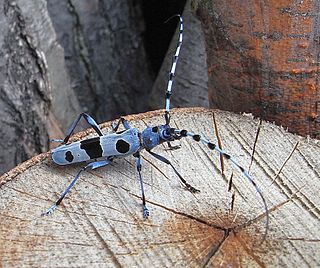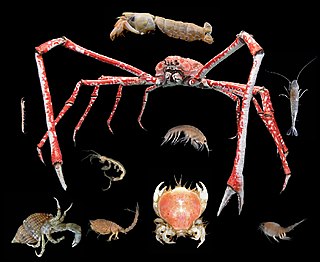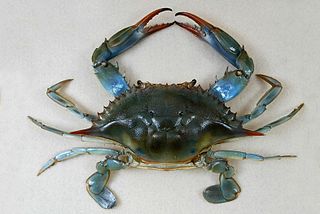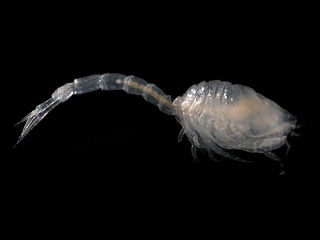
Antennae, sometimes referred to as "feelers", are paired appendages used for sensing in arthropods.

Malacostraca is the largest of the six classes of crustaceans, containing about 40,000 living species, divided among 16 orders. Its members, the malacostracans, display a great diversity of body forms and include crabs, lobsters, crayfish, shrimp, krill, prawns, woodlice, amphipods, mantis shrimp, tongue-eating lice and many other less familiar animals. They are abundant in all marine environments and have colonised freshwater and terrestrial habitats. They are segmented animals, united by a common body plan comprising 20 body segments, and divided into a head, thorax, and abdomen.

Eumalacostraca is a subclass of crustaceans, containing almost all living malacostracans, or about 40,000 described species. The remaining subclasses are the Phyllocarida and possibly the Hoplocarida. Eumalacostracans have 19 segments. This arrangement is known as the "caridoid facies", a term coined by William Thomas Calman in 1909. The thoracic limbs are jointed and used for swimming or walking. The common ancestor is thought to have had a carapace, and most living species possess one, but it has been lost in some subgroups.

Cumacea is an order of small marine crustaceans of the superorder Peracarida, occasionally called hooded shrimp or comma shrimp. Their unique appearance and uniform body plan makes them easy to distinguish from other crustaceans. They live in soft-bottoms such as mud and sand, mostly in the marine environment. There are more than 1,500 species of cumaceans formally described. The species diversity of Cumacea increases with depth.

Diastylidae is one of the eight most commonly recognised families of crustaceans of the order Cumacea. They are marine creatures especially common around the 30th parallel north.

Bodotriidae is a family of crustaceans belonging to the order Cumacea. Bodotriids have a worldwide distribution in shallow and deep waters. There are over 380 described species in over 30 genera, being the most diverse cumacean family. Their external morphology differs from other cumaceans by a combination of traits that independently are not unique to the family: the telson is fused to the last abdominal segment, the dorsal part of the mandible has a boat shape (naviculoid), exopods exist on the third maxilliped and the first peraeopod, and there is a uropodal endopod with one or two articles.

Pseudocumatidae is a family of crustaceans of the order Cumacea. Its members have a small, free telson. The uropods bear endopods on one segment. The males have two pairs of rather rudimentary pleopods and the flagella of the second antenna reach far beyond the pereon. In females the second antenna is much smaller than the first antenna.
Ceratocumatidae is a family of crustaceans of the order Cumacea. Ceratocumatidae have a small free telson. The endopods of the uropods are present on only one segment. Males have 5, 4 or 3 pairs of pleopods. All maxillipeds and some of the pereiopods bear exopods. The gill apparatus has no supporting gill plates.
Gynodiastylidae is one of the eight most commonly recognised families of crustaceans of the order Cumacea. They are especially prevalent in the southern hemisphere, with some types described from Japan, Thailand and the Persian Gulf. Most are found at less than 100 metres (330 ft) depth.

Leuconidae is a family of marine hooded shrimp. The family was established by Georg Ossian Sars in his 1878 study of Mediterranean cumaceans.

Nannastacidae is a family of crustaceans belonging to the order Cumacea. They have no free telson. The endopods of the uropods are present on one segment. There are exopods on the maxillipeds and generally one on pereopods 1–4 in males and 1–2 in females. In the females the second antenna is much shorter than the first. It contains the following genera:

Bodotria scorpioides is a species of crustacean belonging to the order Cumacea. They are found in the East Atlantic, the Mediterranean and the Black Sea. B. scorpioides does not possess a free telson. The first thoracic somite is too short to be seen from above, the second is longer. Both males and females have exopods on the first pereopods only.
Chalarostylis is a genus of cumacean crustaceans in the Lampropidae family, containing two species, including the one formerly placed in Dasylamprops, which is now considered a synonym of Chalarostylis.
Phylogeny of Malacostraca is the evolutionary relationships of the largest of the six classes of crustaceans, containing about 40,000 living species, divided among 16 orders. Its members display a great diversity of body forms. Although the class Malacostraca is united by a number of well-defined and documented features, which were recognised a century ago by William Thomas Calman in 1904, the phylogenetic relationship of the orders which compose this class is unclear due to the vast diversity present in their morphology. Molecular studies have attempted to infer the phylogeny of this clade, resulting in phylogenies which have a limited amount of morphological support. To resolve a well-supported eumalacostracan phylogeny and obtain a robust tree, it will be necessary to look beyond the most commonly utilized sources of data.
Urothoe marina is a species of small marine amphipod crustaceans in the family Urothoidae. It is found on and burrowing in coarse sediments in shallow coastal waters off northwestern Europe.

Nototropis falcatus is a species of amphipod crustacean. It is whitish in colour, with brown patches, and grows to a total length of around 7 mm (0.3 in). It lives on soft sediment such as fine sand at depths of 10 to 50 metres, from northern Norway to the west coast of Ireland, including the North Sea, and as far south as the southern Bay of Biscay.
Mihai Băcescu was a Romanian zoologist.

Crustaceans form a large, diverse arthropod taxon which includes such animals as decapods, seed shrimp, branchiopods, fish lice, krill, remipedes, isopods, barnacles, copepods, amphipods and mantis shrimp. The crustacean group can be treated as a subphylum under the clade Mandibulata. It is now well accepted that the hexapods emerged deep in the Crustacean group, with the completed group referred to as Pancrustacea. Some crustaceans are more closely related to insects and the other hexapods than they are to certain other crustaceans.

Sinocorophium hangangense is a species of gammaridean amphipod found mainly in Korea. The species was found in the lower reaches of Han River in Gyeonggi-do, Korea. The shape of the first and the third uropods, the posterior appendages, alongside the relatively large size of the body distinguishes the Sinocorophium hangangense from other related species.

The clade Multicrustacea constitutes the largest superclass of crustaceans, containing approximately four-fifths of all described crustacean species, including crabs, lobsters, crayfish, shrimp, krill, prawns, woodlice, barnacles, copepods, amphipods, mantis shrimp and others. The largest branch of multicrustacea is the class Malacostraca.













